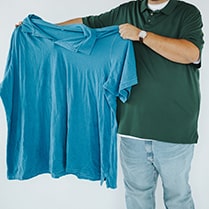
Constant sugar cravings can be frustrating if you are trying to eat healthier after bariatric surgery. There is a science behind sugar cravings, which can be explained based on our hormones and blood glucose levels. In this blog, we will talk about why we crave sugar and what we can do about it.
Often, cravings stem from some chemical imbalance in our bodies. Over time, these cravings are built up in our heads to the point that we will do anything to get that "fix," which can lead to binge eating or disordered eating behaviors.
Cravings are natural feelings that can tell you about your psychology or physiology, and it is okay to give into them every once in a while. But what if they are getting out of control and you want to manage your sugar cravings?
The Sad Reality of Sugar Cravings
Most sugar consumption comes from added sugars in drinks, dressings, packaged goods, etc. In the U.S., the average added sugar intake reaches up to 270 calories, or 13% per day, based on an average 2000-calorie diet. Not surprisingly, the largest source of added sugars in the typical diet is beverages, accounting for 47% of all added sugars consumed by the U.S. population.
The 2015 to 2020 U.S. Dietary Guidelines for Americans recommend limiting added sugars to less than 10% of total calories or about 50 grams per day based on a 2000-calorie diet. For bariatric patients following a 1000-calorie diet, that would be 100 calories of sugar or 25 (or less) grams per day. The American Heart Association has even stricter guidelines to slow the rise of obesity and heart disease, recommending 100 calories per day (24 grams) based on a 2000-calorie diet.
With sugar being a large part of the American diet, especially in pre-bariatric patients, it is no surprise that sugar cravings are seemingly a habitual trait. Simply put, the more sugar we eat, the more we crave it, which gets into the science behind sugar cravings.
The Science Behind Sugar Cravings
In the study of the science behind sugar cravings, research has found that sugar can be as addicting as cocaine. Sugar has a similar effect on the brain's reward center as addictive substances, which explains why it may be so hard to overcome.
Research has shown that sugar can stimulate the hippocampus, a brain region responsible for learning and memory. When the hippocampus is stimulated, it will trigger the release of hormones, such as dopamine (or the "feel good" hormone), which is a part of the brain's "reward system." Apart from actually consuming the food resulting in dopamine release, some studies suggest that the anticipation of food can trigger desires and sugar cravings.
"Sugar cravings are mediated by the mesolimbic dopamine system, which is triggered by cues including smells, sights, and vivid imagery," says Kent Berridge, Ph.D., a professor of psychology and neuroscience at the University of Michigan.
When you eat sugar, dopamine levels rise and amplify the brain pathways that tell you to keep eating. Similarly, research also suggests that sugar stimulates the release of the hunger hormone ghrelin, which is shown to intensify cravings. So, over time, more sugar is needed to reach the same dopamine levels and ultimately feel that "sugar high."

The Dangers of Excess Sugar Consumption
When we consume sugar, it is later converted into glucose as a fuel source for the body; this energy is created through a process called glycolysis. Any extra glucose from the diet is stored in the body as glycogen.
Glucose stores are low compared to the seemingly endless bodily fat stores. Thus, on a healthy eating plan, carbs and sugars are regularly consumed and metabolized into glucose to be used as energy for the brain. While glucose can power the body, uncontrolled levels can lead to complications.
When you eat high-sugar food, blood sugar levels increase. Insulin is secreted from the pancreas to normalize levels through glucose (sugar) uptake into the body’s cells. However, the more sugar you consume, the less responsive your cells become to insulin. Blood sugar doesn’t get into cells and thus, can’t be stored for energy. When sugar can’t enter these cells, high blood sugar levels occur (this is called hyperglycemia). Over time, this can lead to insulin resistance and ultimately type 2 diabetes.
Conclusion
We all experience sugar cravings, which seem to intensify when we try to restrict this food group. Understanding the science behind sugar cravings explains why overcoming this “addiction” can be so hard.
The best advice for someone looking to overcome intense sugar cravings is to start slow and focus on the environmental cues that might lead to consuming excess sugar. We also recommend reducing sugar in your diet by swapping certain foods, such as juice for Crystal Light or dressing for a homemade vinegarette.












